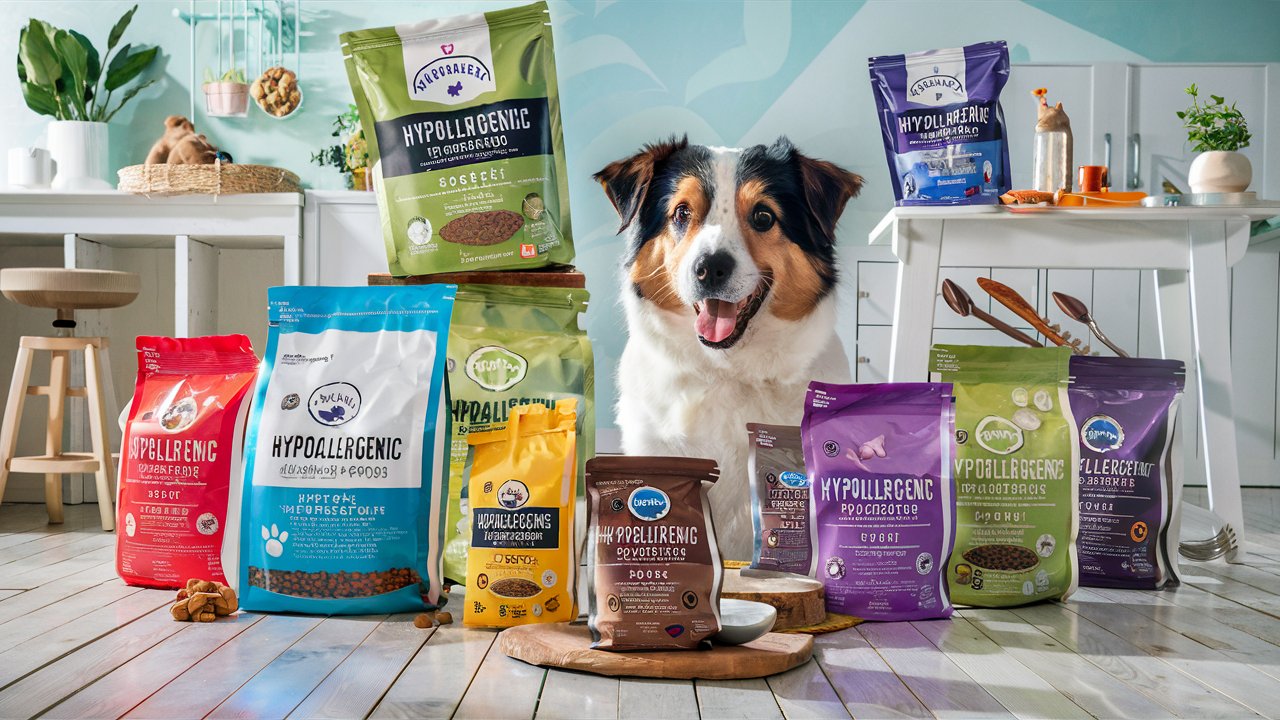Ultimate Guide to Healthy Hypoallergenic Dog Food
If you’re a pet owner, you know how important it is to provide the best care for your furry friends. However, when your dog has allergies, finding the right food can be a daunting task. This is where hypoallergenic dog food comes in. In this article, we will delve into the world of hypoallergenic dog food, exploring what it is, why it’s important, and how to choose the best option for your dog.
Table of Contents
ToggleUnderstanding Dog Allergies
Dog allergies can manifest in several ways, including skin irritations, digestive issues, and respiratory problems. Common allergens include certain proteins, grains, and additives found in many commercial dog foods. Symptoms of allergies in dogs can include itching, redness, ear infections, vomiting, diarrhea, and excessive licking or chewing of the paws.

Personal Anecdote:
When my dog, Max, started scratching incessantly and developed red patches on his skin, I was both worried and frustrated. After several visits to the vet, we discovered he had a food allergy. This journey led me to explore hypoallergenic dog foods, which have made a world of difference for Max.
What is Hypoallergenic Dog Food?
Hypoallergenic dog food is specifically formulated to minimize the risk of allergic reactions. These foods typically use novel or hydrolyzed proteins and are free from common allergens such as beef, chicken, wheat, corn, and soy. Novel proteins are sourced from animals that are not commonly used in pet foods, such as venison, duck, or fish. Hydrolyzed proteins are proteins that have been broken down into smaller components, making them less likely to trigger an allergic reaction.
Benefits of Hypoallergenic Dog Food
- Reduced Allergic Reactions: The primary benefit of hypoallergenic dog food is the reduction of allergic reactions. By eliminating common allergens, these foods help alleviate symptoms like itching, digestive upset, and ear infections.
- Improved Digestion: Many hypoallergenic dog foods are designed to be easily digestible, which can help dogs with sensitive stomachs.
- Enhanced Skin and Coat Health: By removing allergens and providing balanced nutrition, hypoallergenic dog food can lead to healthier skin and a shinier coat.
- Better Overall Health: With fewer allergens, dogs can experience improved energy levels, weight management, and overall well-being.
Choosing the Right Hypoallergenic Dog Food
Selecting the right hypoallergenic dog food involves understanding your dog’s specific needs and preferences. Here are some tips to guide you:
- Consult Your Veterinarian: Before making any changes to your dog’s diet, consult with your veterinarian. They can help identify the specific allergens affecting your dog and recommend suitable hypoallergenic options.
- Read Labels Carefully: Look for foods labeled as hypoallergenic or limited ingredient. Check the ingredient list for novel or hydrolyzed proteins and avoid common allergens.
- Consider Your Dog’s Preferences: Some dogs may prefer wet food over dry food or have a taste preference for certain proteins. It may take some trial and error to find the perfect match.
- Monitor Your Dog’s Response: After switching to hypoallergenic dog food, observe your dog for any changes in symptoms. It may take several weeks to see significant improvements.
Personal Anecdote:
After switching Max to a hypoallergenic diet, it took about three weeks to notice a significant reduction in his symptoms. His skin cleared up, and he seemed much happier and more energetic. It was a relief to see him comfortable and thriving again.
Popular Hypoallergenic Dog Food Brands
Several brands are known for their high-quality hypoallergenic dog foods. Here are a few reputable options:
- Royal Canin Veterinary Diet: Known for its veterinary-recommended formulas, Royal Canin offers several hypoallergenic options, including hydrolyzed protein diets.
- Hill’s Prescription Diet: Hill’s offers a range of hypoallergenic and limited-ingredient diets designed to address various health issues, including food allergies.
- Blue Buffalo Basics: Blue Buffalo’s Basics line features limited-ingredient diets with novel proteins like turkey and duck, making it a good option for dogs with food sensitivities.
- Natural Balance L.I.D.: Natural Balance Limited Ingredient Diets are formulated with a single animal protein source and limited carbohydrates, ideal for dogs with allergies.
- Wellness Simple: Wellness Simple offers grain-free, limited-ingredient diets that focus on easily digestible ingredients and high-quality proteins.

Homemade Hypoallergenic Dog Food Recipes
For pet owners who prefer a more hands-on approach, homemade hypoallergenic dog food can be a viable option. This allows for complete control over the ingredients and ensures that no allergens are included. Here are two simple recipes to try:
Recipe 1: Turkey and Sweet Potato
- Ingredients:
- 1 pound ground turkey
- 1 cup cooked sweet potatoes, mashed
- 1/2 cup cooked peas
- 1/2 cup cooked carrots, diced
- 1 tablespoon olive oil
- Instructions:
- Cook the ground turkey in a skillet over medium heat until fully cooked.
- Mix in the mashed sweet potatoes, peas, and carrots.
- Drizzle with olive oil and stir to combine.
- Allow the mixture to cool before serving.
Recipe 2: Fish and Quinoa
- Ingredients:
- 1 pound white fish fillets (such as cod or haddock)
- 1 cup cooked quinoa
- 1/2 cup cooked spinach, chopped
- 1/2 cup cooked carrots, diced
- 1 tablespoon coconut oil
- Instructions:
- Bake or steam the fish fillets until fully cooked, then flake into small pieces.
- Combine the fish, quinoa, spinach, and carrots in a bowl.
- Add the coconut oil and mix well.
- Allow the mixture to cool before serving.
Personal Anecdote:
Making homemade dog food for Max has been a rewarding experience. Not only do I know exactly what he’s eating, but I can also adjust recipes to suit his tastes and nutritional needs. Plus, he seems to enjoy the meals I prepare for him more than any store-bought options.
Conclusion
Finding the right hypoallergenic dog food can make a significant difference in your dog’s health and quality of life. By understanding the causes of allergies and selecting foods that are free from common allergens, you can help alleviate your dog’s symptoms and ensure they thrive. Whether you choose a commercial hypoallergenic dog food or decide to make your own, the key is to provide a balanced, nutritious diet that meets your dog’s specific needs.
Remember, every dog is unique, and what works for one may not work for another. Patience and careful observation are essential in finding the best solution for your furry friend. If you’re ever in doubt, consulting with your veterinarian is always the best course of action.

Personal Anecdote:
Max’s journey with food allergies taught me the importance of paying attention to his diet and overall health. With the right hypoallergenic dog food, he’s now a happy, healthy dog, and I couldn’t be more grateful. For pet owners facing similar challenges, I hope this guide provides the information and encouragement needed to find the best diet for their beloved pets.






